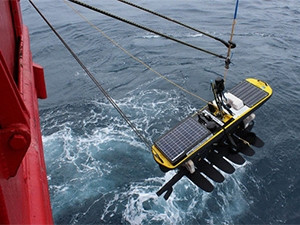
Robotic gliders deployed by the Council for Scientific and Industrial Research's (CSIR's) Southern Ocean Carbon and Climate Observatory unit are set to shape the future of marine research and environmental monitoring of the Southern Ocean and South African waters.
The gliders are observing the ocean's physical processes, studying their impacts on carbon dioxide exchange between the atmosphere and ocean, and the growth of phytoplankton - microscopic algae that live on the ocean surface.
These gliders were first tested in 2012, and Dr Sebastiaan Swart, a principal scientist with the CSIR, says so far they have made headway in collecting invaluable data in the oceans. He believes this data will be crucial in determining how human activity is making an impact on marine life.
According to Swart, sensitivity of the Southern Ocean to climate change is a prime concern because the creatures living there are susceptible to minor environmental shifts, possibly leading to large changes in global ocean currents.
"One of the research gaps that we hope to address with these gliders, in conjunction with satellites and computer models, is better understanding the role of small-scale features such as ocean eddies and currents and short-term events [storms] on the overall state of the ocean," Swart says.
Before glider technology was available, he says, measuring these forms of features and variability were impossible - investigations from research ships and satellite data alone were not enough.
"Enhancing our understanding of how the Southern Ocean works and interacts with climate today will leave us in a position to better mitigate the effects of climate change tomorrow," he points out.
The robotic gliders fleet totals nine - and could increase to match the growing needs of the global researchers. Four surface wave gliders ride the ocean surface measuring carbon dioxide and acidity, among other surface ocean physical variables. Five of the gliders can dive to a maximum depth of one kilometre below the ocean surface, Swart says.
When deployed, the gliders "tweet" data to scientists in Cape Town where it is stored, analysed and eventually made available to the global researchers, explains Swart.
CSIR researchers combine analysis of data from surface wave and profiling gliders by pairing them together while deployed in the ocean, providing a complete picture of changes in the water, he adds.
Researchers from the CSIR also equipped the gliders with an acoustic echo sounder to determine fish stock levels along the South African coast.
The Department of Agriculture, Forestry and Fisheries (DAFF) has the responsibility to determine the available fish stock levels in SA's Exclusive Economic Zone (EEZ) to regulate and allocate fishing quotas. The EEZ is a sea zone prescribed by the United Nations over which a state has special rights in terms of the exploration and use of marine resources.
Scientists from DAFF currently conduct these surveys by following a predetermined route along the coast. Once the on-board underwater sonar detects species that resemble fish, a net is drawn to capture a sample of the species. Using the two types of data, fishing quotas are then established.
The technology components comprise a sonar system to detect fish and a data-capturing unit installed on an unmanned marine vehicle that serves as the sensor platform. The integration of these technology components was supported by industry partner, marine technology company Sea Technology Services, which provided insights gained from experience in the development of such marine vehicles.
The vehicle relies on wave propulsion to glide forward, making it possible for the vessel to be deployed for months at a time. The data-capturing and control unit is housed in a payload compartment made available by Liquid Robotics.
The gliders are manufactured in the US, but modified in SA through adding and building new sensors to suit local needs. They are maintained by the CSIR-led SA Marine Engineering and Robotics Centre, and Sea Technology Services.
Share